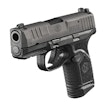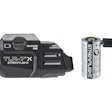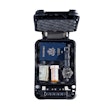I would be willing to bet cash money that if you were to ask any veteran American law enforcement officer who is over the age of 35 to tell you what a “Military & Police” is, he or she would answer “Smith & Wesson’s most popular revolver.”
For most of the 20th century, the Smith & Wesson .38 Hand Ejector Military & Police (Model 10) revolver was the hands-down favorite sidearm of local, state, and federal police agencies in North America.
Introduced in 1899, the M&P revolver served as the launching platform for the most common revolver cartridge, the .38 S&W Special. More than 6 million M&P revolvers have been produced and manufactured, and the Model 10 is still being made today.
But times have changed since the days when almost every cop carried a .38 revolver. In the mid-1980s, American police switched their preference en masse from the revolver to the semi-auto pistol. And while S&W had a complete line of self-loading pistols, other manufacturers jumped into the market, and it wasn’t long before such brands as Glock, SIG, and Beretta had captured a significant share of the American police handgun market.
To counter the slide in its police sales, S&W has spent the last few years developing a new pistol that it believes addresses many of the problems inherent to polymer frame pistols. Now, I’m sure some of you are saying, “Great. That’s just what we need, another plastic pistol.” Well, be patient and keep reading because the M&P is not just another plastic pistol.
S&W introduced the new Military & Police Pistol late last year to a group of firearms writers, including myself. The event, which was held at S&W’s headquarters in Springfield, Mass., opened with Joe Bergeron explaining to us that the company saw the M&P as the means of recapturing the dominant position it once held in the U.S. police market. After attending a series of product lectures, observing the manufacturing process, and spending some trigger time with the M&P, I knew that it was really something special, and I wanted to evaluate it more thoroughly.
Design and Construction
The M&P’s frame design is what really sets it apart from its competitors. Immediately noticeable is an extended beavertail, which secures the pistol in the shooter’s hand and provides enhanced recoil control for fast, accurate follow-up shots. A grip angle of 18 degrees makes the M&P a natural “pointer.”
Less obvious but equally important is the M&P’s construction. Ridged steel rails are imbedded on either side of the M&P’s Zytel frame. They run from the front locking block to the rear sear housing block and not only strengthen the frame itself, but also reduce torque and frame flexing. In addition, the rails help create a chassis that provides consistent alignment of the trigger and sear, which cannot be affected by the expansion and contraction of the frame caused by heat or cold.
The M&P’s slide reciprocates on four steel rails. Two are part of the frame-mounted locking block, while the others are integral to the steel sear housing at the rear of the frame. These have, when viewed from the top, an oval shape that provides a small frame rail/insert bearing surface that provides sufficient support while reducing friction. They have the added benefit of creating a self-cleaning action, which removes debris from the frame rails to further enhance reliability.
M&P slides and barrels are machined from solid stainless steel then “through hardened.” This process produces both external and internal hardening. Both the slide and barrel also receive S&W’s proprietary Melonite finish, a heat treatment that not only protects the surface but penetrates the metal, combined with the through-hardening process produces a surface hardness of 68 HRc. This translates into enhanced immunity from wear and the environmental extremes that the pistol is likely to encounter during police service. In addition, the slide rails are thicker than those on most other brands of pistols.
M&P barrels have a “cone” muzzle configuration to provide consistent positioning for enhanced accuracy and produce less friction as the slide reciprocates. A captive recoil spring rides on a full-length, steel guide rod, while a semi-circular cut at the rear of the barrel hood allows the shooter to verify whether there is a round in the chamber.
Reliability is enhanced by an oversized extractor whose external location makes repair and replacement fast and simple. Novak Lo-Mount three-dot sights are standard but for those agencies desiring higher tech equipment, options include Trijicon night sights.
Because the M&P is a duty pistol, the designers wanted to make it easy to draw and reholster. Reholstering—especially when performed one handed—is facilitated by the tapered profile of the nose of the slide, while sharp cut serrations allow the slide to be retracted smooth, even with wet hands or when wearing gloves. An oversized trigger guard makes the M&P more user-friendly for officers wearing gloves while all edges, including those of the sights, are beveled to prevent abrasion to the shooter’s hands.
Breech locking is achieved by a barrel hood bearing on the front edge of the ejection port. When the pistol is fired, the barrel and slide move back and lock together until an angled lug on the barrel cams the barrel down on a frame-mounted locking block, allowing the slide to continue back, extracting and ejecting the spent cartridge case. The recoil spring then pulls the slide forward, stripping a new round from the magazine and chambering it. As the slide and barrel go into battery, the barrel hood moves up into the ejection port, locking the two units together.
[PAGEBREAK]
A major problem facing any department when it adopts a handgun is the variation in hand size among its officers. The M&P makes this problem moot as it features interchangeable palmswells that allow the individual officer to custom fit the pistol to his or her hand. The palmswells can be quickly changed by rotating a catch at the bottom of the grip frame and withdrawing a pin.
The M&P will be available chambered for the 9mm Parabellum, .357 SIG, and .40 S&W cartridges, and uses a steel, fifteen-round (17 rounds in 9mm) magazine.
Safety First
The M&P features a double-action-only (DAO) trigger pull. This type of trigger has become very popular with law enforcement agencies over the last few years. It provides both simplicity of operation and the enhanced safety of a long trigger stroke, approximately 0.3 inches.
Backing up the DAO trigger are three safeties: a trigger safety, a firing pin safety, and a magazine disconnect safety. The trigger safety prevents movement until the pivoting bottom section of the trigger is pulled. The firing pin safety consists of an internal, spring-loaded plunger that prevents firing pin movement until a full-length stroke of the trigger deactivates it. Removing the magazine causes the magazine disconnect safety to engage. The safety is a lever at the rear of the magazine well that pivots forward when the mag is removed, moving the trigger bar out of alignment with the sear. Reinserting the magazine realigns the two units, allowing the pistol to be fired.
In addition to the three primary safeties, there are other precautions built into the M&P. As on most new S&W handguns, an Internal Safety System (ISS) (essentially a lock) is standard on the M&P. Inserting a key into a small hole on the left rear of the frame and rotating a shaft activates the magazine disconnect safety and prevents unauthorized firing of the pistol whether or not a magazine is in the pistol. (Law enforcement customers may order the M&P without the ISS.) Lastly, the M&P’s slide must be locked open, and a sear deactivation lever rotated, before it can be disassembled. This system requires that the person cleaning the weapon first verify there is not a round in the chamber. It is not necessary to pull the trigger before removing the slide from the frame.
On the Range
Once I had ascertained which size of palmswell best fit my hand, I found my evaluation M&P .40 to be a well-balanced, naturally pointing handgun. The trigger pull was smooth and consistent and broke at a measured 6.6 pounds. One minor complaint was that I had trouble feeling the reset “click” when letting the trigger forward slowly.
I ran the M&P through a series of offhand drills on combat targets set at ranges of seven and 10 yards, firing the pistol both supported and unsupported. Thanks to the beavertail and the tacky feeling palmswells, recoil control was above average for a handgun, weighing less than 28 ounces. The three-dot sight system allowed rapid sight alignment allowing fast follow-up shots to be performed with aplomb. Every round I fired impacted in the USPSA targets’ A, B, and C zones. I was impressed with its accuracy.
Over the next few weeks, I took the M&P to the range several more times, eventually running in excess of four hundred rounds through it without a single failure to feed, fire, extract, or eject.
If you or your agency are in the market for a polymer frame pistol that exhibits all of the characteristics required of a police service weapon, I’d advise you to check out Smith & Wesson’s new M&P. I feel confident in predicting that you will be suitably impressed.
Paul Scarlata has served as an auxiliary police officer and writes for several firearms publications.
Disassembling the M&P .40
1. Remove magazine, verify that the chamber is empty, and lock open the slide.
2. Looking down through the ejection port into the magazine well, you will see the yellow, U-shaped sear deactivation lever. Using a small screwdriver or similar device, rotate the lever down and forward.
3. Rotate the take-down lever on the left side of the frame downward 90 degrees.
4. While holding the slide firmly, pull it to the rear slightly, and then allow it to run forward off the frame.
5. Holding the slide upside down, push the recoil spring/guide rod unit forward slightly and remove.
6. Pull the barrel down and out of the slide.
7. Reassemble in reverse. Note: inserting a magazine will push the sear deactivation lever up.
Smith & Wesson M&P .40 Semi-Automatic Pistol
Caliber: .40 S&W
Capacity: 15 rounds
Overall Length: 7.5 inches
Barrel Length: 4.25 inches
Height: 5.5 inches
Width: 1.2 inches
Weight (unloaded): 27.45 ounces
Construction:
Frame: Zytel polymer
Slide: stainless steel with Melonite finish
Sights: Front, steel ramp Rear, Novak Lo-Mount
Price: $695
Website: www.smith-wesson.com














